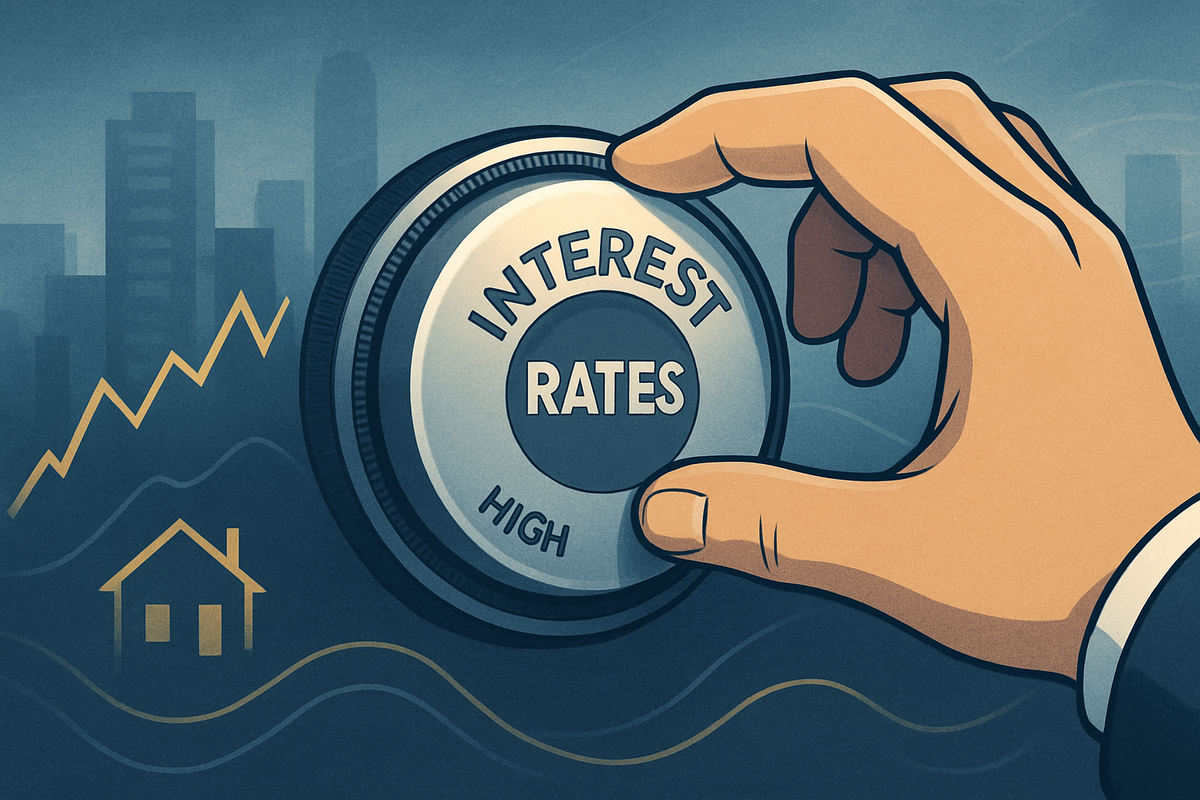
The financial world is abuzz with anticipation as Federal Reserve Governors have increasingly signaled their support for further interest rate cuts, with a 25-basis-point reduction widely expected at the upcoming Federal Open Market Committee (FOMC) meeting on October 28-29, 2025. This move, following a similar cut in September, would bring the federal funds rate to a range of 3.75% to 4.00%, marking a significant pivot in monetary policy aimed at bolstering a decelerating economy and a softening labor market.
These dovish signals from the Fed are reverberating across financial markets, influencing everything from bond yields and stock valuations to the housing market and investor sentiment. As the central bank recalibrates its approach, MarketMinute delves into the reasons behind this shift and its profound implications for investors navigating an evolving economic landscape.
The Fed's Dovish Turn: Unpacking the Rationale and Market Reaction
The chorus of Federal Reserve officials advocating for lower rates has grown louder, driven primarily by emerging concerns about the health of the U.S. economy. Federal Reserve Chair Jerome Powell has been a prominent voice, emphasizing that a significant slowdown in hiring poses a growing risk. He indicated that the Fed is likely on track for two more rate cuts this year, stating that "rising downside risks to employment have shifted our assessment of the balance of risks." Powell also hinted at the possibility of the central bank soon ceasing to shrink its balance sheet, a further easing measure.
Other key players have echoed these sentiments. Fed Governor Michael Barr, in an October 9th speech, highlighted "considerable uncertainty about the future course of the economy," while Boston Fed President Susan Collins has advocated for continued easing to bolster the labor market. Notably, Fed Governor Stephen Miran, a more vocal proponent of steeper cuts, pushed for a 50-basis-point reduction in September and reiterated his support for lower rates, citing escalating trade tensions with China as an additional factor. The overarching reasons for these cuts include a softening and deteriorating labor market, inflation slightly above the Fed's 2% target (though some view tariff-related price increases as temporary), decelerating economic growth, and the complicating factor of the ongoing government shutdown, which has delayed crucial economic data.
Financial markets have largely priced in the expectation of an October rate cut, with the CME FedWatch Tool indicating a high probability of a 25-basis-point reduction. This anticipation has spurred several immediate reactions: U.S. equity futures for the Dow, S&P 500, and Nasdaq have shown increases, signaling investor optimism for cheaper money to fuel growth. Gold futures have also seen an uptick, reflecting a flight to safe-haven assets. Concurrently, the yield on the U.S. 10-year Treasury note has fallen towards 4%, nearing April lows, as Powell's comments reinforced expectations of more rate cuts. Perhaps most significantly for the average American, mortgage rates are falling, with the average U.S. 30-year fixed mortgage rate dropping to 6.31% as of October 15, 2025, the lowest level in over a year, potentially offering a turning point for the housing market.
Winners and Losers: Corporate America's Response to Lower Rates
The prospect of sustained lower interest rates will inevitably create distinct winners and losers across various sectors of the financial market. Companies with high growth potential, particularly in the technology sector, often thrive in a low-rate environment as borrowing costs decrease and future earnings are discounted at a lower rate, making their valuations more attractive. Tech giants like Apple (NASDAQ: AAPL), Microsoft (NASDAQ: MSFT), and Amazon (NASDAQ: AMZN), which often rely on financing for expansion or whose valuations are heavily tied to future growth, could see renewed investor interest.
The housing market stands to be a significant beneficiary. Lower mortgage rates directly translate to increased affordability for prospective homebuyers and provide an incentive for existing homeowners to refinance. This could ignite activity for homebuilders such as D.R. Horton (NYSE: DHI) and Lennar (NYSE: LEN), as well as real estate companies and mortgage lenders. Consumer discretionary companies, including retailers and automotive manufacturers like Tesla (NASDAQ: TSLA), could also see a boost as consumers benefit from lower borrowing costs for big-ticket purchases.
Conversely, the financial sector, particularly traditional banks, may face headwinds. While lower rates can stimulate economic activity, they also tend to compress net interest margins (NIMs)—the difference between what banks earn on loans and what they pay on deposits. Major banks like JPMorgan Chase (NYSE: JPM) and Bank of America (NYSE: BAC) might see their profitability squeezed if rates fall too quickly or too far. Additionally, sectors that typically perform well in higher interest rate environments, such as certain utilities or mature dividend-paying stocks that offer yield as an alternative to bonds, might see some of their relative attractiveness diminish.
Wider Significance: A Broader Economic Rebalancing Act
The Federal Reserve's pivot towards interest rate cuts is not merely a tactical adjustment; it represents a significant rebalancing act within the broader economic landscape. This shift signals the Fed's heightened concern for the labor market and overall economic growth, moving away from its aggressive inflation-fighting stance of the preceding period. It suggests that while inflation remains a consideration, the central bank now perceives the risks of an economic downturn or a significant rise in unemployment as more pressing. This fits into a broader trend of central banks globally adapting to evolving economic data, often prioritizing stability and growth when inflationary pressures show signs of moderation or are deemed transitory.
The regulatory and policy implications extend beyond just the federal funds rate. Chair Powell's hint about potentially ceasing the shrinking of the Fed's balance sheet—a process known as quantitative tightening—would be another significant easing measure. This would inject more liquidity into the financial system, further supporting economic activity. Historically, such shifts from tightening to easing cycles have often occurred when economic indicators signal a slowdown or recessionary risks emerge. Comparisons can be drawn to periods like the mid-2000s or even earlier, where the Fed eased policy to counteract perceived economic weaknesses, albeit under different inflationary and geopolitical contexts.
The ripple effects of this policy shift are likely to extend beyond U.S. borders. A more dovish Fed can influence global capital flows, potentially weakening the U.S. dollar and making U.S. assets more attractive to international investors. This could have implications for emerging markets, commodity prices, and the monetary policy decisions of other central banks worldwide, as they adjust to a potentially more accommodating global financial environment. The ongoing trade tensions, particularly with China, and their impact on global supply chains and inflation, further complicate this delicate balancing act, adding a layer of uncertainty to the Fed's decision-making process.
What Comes Next: Navigating the Path Ahead
Looking ahead, the immediate focus will undoubtedly be on the Federal Reserve's upcoming FOMC meetings. With a 25-basis-point cut anticipated in October and another widely expected in December, market participants will be scrutinizing every statement and economic projection for clues about the pace and extent of future easing. The resolution of the government shutdown will be critical, as the release of delayed economic data will provide the Fed with a clearer picture of the labor market, inflation, and overall economic health, potentially influencing decisions beyond 2025.
In the short term, investors should anticipate continued volatility as markets digest the implications of lower rates. Sectors sensitive to interest rates, such as real estate, utilities, and high-growth technology stocks, could experience significant movements. Strategic pivots may be required for portfolios heavily weighted in areas that thrived during higher rate environments. Long-term possibilities include a sustained period of lower rates if economic growth remains subdued and inflation stays contained, which could foster an environment conducive to corporate investment and consumer spending, albeit with potential risks of asset bubbles if liquidity becomes excessive.
Potential scenarios range from a "soft landing" where the Fed successfully engineers a modest slowdown to control inflation without triggering a recession, to a more challenging environment if economic indicators continue to deteriorate despite rate cuts. Market opportunities may emerge in areas that benefit from cheaper credit, while challenges could arise for companies with high debt loads that might have relied on refinancing at even lower rates. Investors should closely monitor labor market reports, inflation data, and any further developments in global trade relations, as these will be key determinants of the Fed's future policy trajectory.
A New Chapter for Monetary Policy: Investor Readiness
The Federal Reserve's clear signals of support for interest rate cuts mark a significant turning point in monetary policy, shifting from a period of tightening to one of easing. The key takeaway is the Fed's renewed focus on supporting the labor market and economic growth, even as inflation remains slightly above target. This pivot is already reshaping financial markets, with bond yields falling, equity futures rising, and mortgage rates declining, suggesting a potential revitalization for the housing sector and certain growth-oriented industries.
Moving forward, the market will likely be characterized by a careful balancing act. While lower rates generally provide a tailwind for equities and stimulate borrowing, the underlying economic concerns that prompted these cuts—a softening labor market and decelerating growth—cannot be ignored. Investors should assess their portfolios for exposure to rate-sensitive sectors and consider how a prolonged period of lower rates might impact their long-term investment goals.
The lasting impact of this policy shift will depend on the Fed's ability to navigate the complex interplay of inflation, employment, and economic growth without overshooting or undershooting its targets. What investors should watch for in the coming months includes the actual implementation of the expected rate cuts, the Fed's forward guidance on future policy, and critically, the evolution of key economic data, especially labor market statistics and inflation reports, which will ultimately dictate the path of monetary policy into 2026 and beyond.
This content is intended for informational purposes only and is not financial advice







